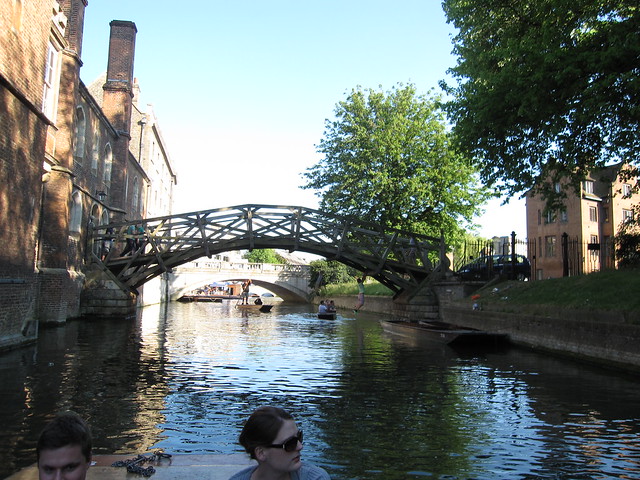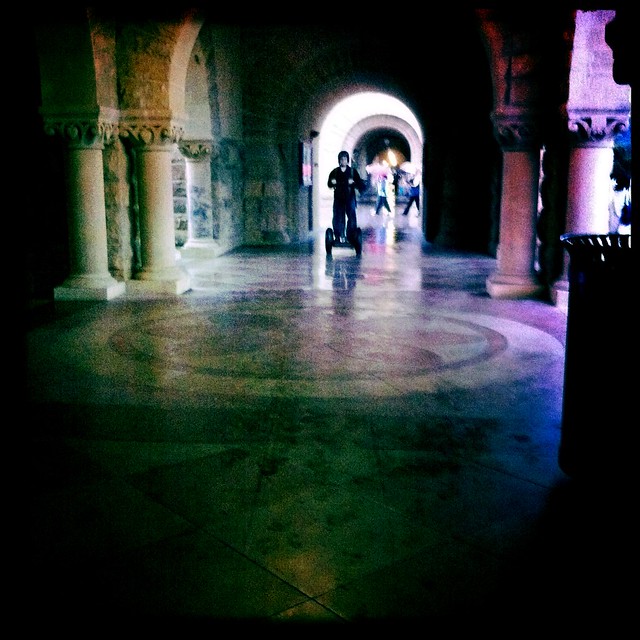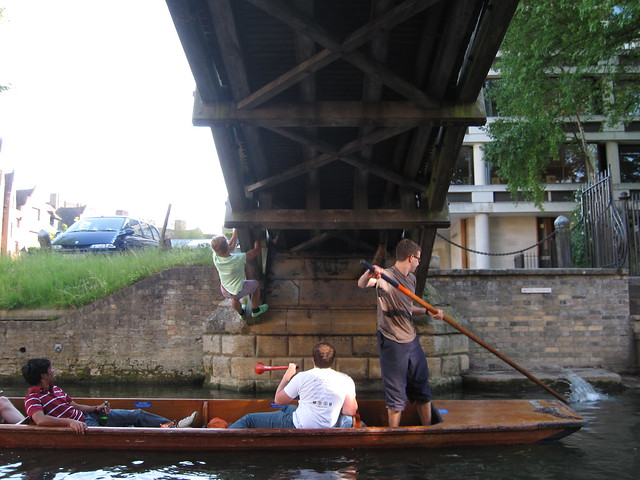
Mathematical Bridge, Cambridge
It may not be on your calendar, but Sunday October 16 is Hamilton Day, the anniversary of the day Irish mathematician William Rowan Hamilton carved his most famous insight, on the algebra of quaternions, on a bridge while walking with his wife. This is one of the more famous examples of an “a-ha” moment in the history of science; because it is well-documented, it illustrates several features of such events that sometimes get overlooked.
Today quaternions are used in 3D game engines and graphics (among many places), because they provide a very efficient way of describing how objects should move. (Slate has a more detailed explanation of them.) Hamilton had long been interested in complex numbers, numbers that include the “imaginary” number i (the number whose square equals -1). Real numbers can be represented on a number line– for example, 1, 2, 3, and 64 can all be placed on the same line– and complex numbers can be mapped onto a plane. What about numbers that can be described using three dimensions, and have more than one imaginary number? How would you perform basic algebraic functions on these “triplets,” as Hamilton called them– e.g., adding them together, or subtracting them, or multiplying and dividing them? Addition and subtraction were not so hard, but multiplication was a challenge.
On October 16, 1843, while walking with his wife along the Royal Canal, “an under-current of thought was going on in my mind, which gave at last a result, whereof it is not too much to say that I felt at once the importance,” he later wrote to one of his sons. “An electric circuit seemed to close; and a spark flashed forth.” He took out a knife and wrote the equation on a stone on the Broome Bridge, to guarantee the insight wouldn’t be lost. The way to solve the problem, he realized, was not to work with triplets, but to work with quaternions, numbers whose value could be represented in four dimensions, but which could be multiplied more easily.
But there’s more to the story. We often focus on these moments of insight because they’re dramatic, and are good stories; but this can obscure the fact that they’re part of a much bigger process. Graham Wallas argued that there are four stages in the creative process, or the “art of thought” as he called it (interestingly, he never uses the word “creativity” in his study): preparation, incubation, illumination, and verification.
Moments of illumination, he noted, don’t actually happen without periods of work (the preparation) and rest (the incubation): the flash of insight isn’t a shortcut, but the culmination, of a long process. Your mind needs to have a lot of facts stored, a history of working on the problem, a sense of which approaches to the problem are promising and which are dead ends.

One more view of the Mathematical Bridge
Hamilton’s moment on the bridge on October 16, 1843 felt like a bolt of lightning, but the insight arrived after years of effort: “I felt a problem to have been at that moment solved– an intellectual want received– which had haunted me for at least fifteen years,” he said. In fact, he had been working on it for so long that even his children had developed a ritual: “on my coming down to breakfast,” Hamilton later recalled to one son, “your (then) little brother William Edwin, and yourself, used to ask me, ‘Well, Papa, can you multiply triplets’? Whereto I was always obliged to reply, with a sad shake of the head: ‘No, I can only add and subtract them.’”
Another characteristic piece of the story is that he was walking when he had the insight. Many stories of illumination take place while the thinker is in motion. Erno Rubik, inventor of the Rubik’s Cube, had an epiphany about how to design a connector that holds the blocks in his cube together while allowing them to rotate while walking along the banks of the Danube.
In his account of the discovery of Fuschian functions, the great French mathematician Henri Poincaré describes a series of a-ha moments that came while boarding a bus, on a walk on a seaside bluff near Caen, and walking down the street in Paris.
And we now have experimental evidence that walking and creativity work together: Stanford psychologists Daniel Schwartz and Marily Oppezzo found that even walking on a treadmill that faces a cinder block wall stimulates creativity.

The Main Quad, Stanford University
Another easy-to-overlook element in the story is that such moments of illumination tend to come to people who have spent time cultivating the ability to move through the preparation and incubation phases. Geneticist and Nobel laureate Barbara McClintock recalled a walk at Stanford when she was working on an especially tricky problem as a turning point in her creative life. She had long gone on walks to help shake loose ideas, but after her Stanford walk she felt a new level of confidence in and control over the process: from then on, she could “summon it when needed, and to use it in the service of scientific discovery,” she told her biographer.
As a teenager, Hamilton had discovered that “A long walk is a fine opportunity for wooing the Muse,” and for much of his life he walked as a way of helping solve challenging problems. His moment on the bridge wasn’t a one-time event, in other words; he had spent years learning how to use walks to shake loose ideas.
The examples of Hamilton and others show, I argue in my book, that we should treat deliberate rest as a skill. Whether he was conscious of it or not at first, Hamilton discovered in his teens that walking was a way to stimulate his creative thinking, and he appears to have used that knowledge to help him solve problems. Likewise McClintock definitely used walks to get her creative mind going. Even if he didn’t plan for them in quite the same way (it’s not clear to me), Poincaré wasn’t surprised that insights came while he was walking. We can learn from their examples, and from more recent work on walking and insight, to help ourselves become more reliably creative.


